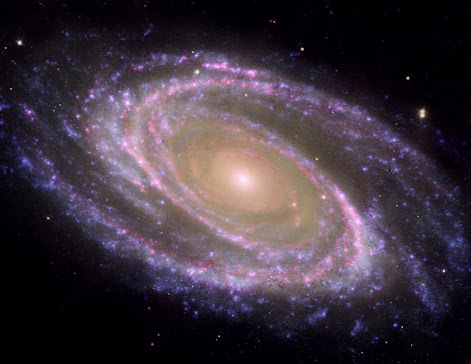Messier 81: A Spiral Marvel in the Cosmic Sea
Messier 81, a spiral galaxy in Ursa Major, boasts a classic structure with sweeping arms and a bright central bulge. Hosting billions of stars of various sizes and ages, it serves as a stellar nursery, birthing hundreds of stars annually. Spanning 90,000 light-years, its interactions with neighboring galaxies, notably Messier 82, make it a unique cosmic spectacle, offering astronomers valuable insights into galactic evolution.
The Shape and Location:
Messier 81 showcases the classic spiral structure that defines many galaxies, including our own Milky Way. Its prominent spiral arms sweep gracefully outward from a bright central bulge, creating a mesmerizing celestial whirlpool. Located approximately 11.8 million light-years away from Earth, M81 occupies a prominent place in the night sky, making it accessible to amateur astronomers with modest telescopes.
Stars in Messier 81:
Within the sprawling arms of Messier 81 lie billions of stars, each contributing to the galaxy's luminous beauty. These stars come in various sizes, ages, and colors, forming a tapestry of stellar diversity. From massive, hot blue stars to smaller, cooler red stars, Messier 81 hosts a stellar population that intrigues astronomers seeking to unravel the galaxy's evolutionary history.
Star Formation in M81:
One of the most fascinating aspects of Messier 81 is its role as a stellar nursery, where new stars are born amidst the cosmic dance of gas and dust. The galaxy's spiral arms serve as fertile grounds for star formation, with dense clouds of molecular gas collapsing under their own gravity to give birth to clusters of young stars. While the exact rate of star formation in M81 varies over time, astronomers estimate that hundreds of new stars are born in the galaxy each year, contributing to its ongoing evolution.
Size of Messier 81:
Messier 81 spans an impressive diameter of approximately 90,000 light-years, making it slightly smaller than the Milky Way. Despite its substantial size, M81 is classified as a dwarf spiral galaxy compared to larger galaxies like the Andromeda Galaxy (M31) or the Triangulum Galaxy (M33). However, its relatively close proximity to Earth allows astronomers to study its structure and dynamics in detail, providing valuable insights into the nature of spiral galaxies.
Connection with Messier 82:
What sets Messier 81 apart from other galaxies is its unique interactions with its celestial neighbors. Through gravitational interactions, M81 has formed a close galactic pair with its companion galaxy, Messier 82 (M82). This interaction has triggered intense bursts of star formation in M82, leading to its classification as a starburst galaxy. Additionally, Messier 81 exhibits peculiar features in its outer regions, likely influenced by past interactions with smaller satellite galaxies.
Conclusion:
Messier 81 stands as a stellar example of the beauty and complexity of the universe. Its graceful spiral arms, bustling stellar population, and ongoing interactions with neighboring galaxies offer a wealth of opportunities for astronomers to study the dynamics of galactic evolution. As we continue to explore the mysteries of Messier 81 and its cosmic companions, we deepen our understanding of the intricate tapestry that is the universe.

Comments
Post a Comment